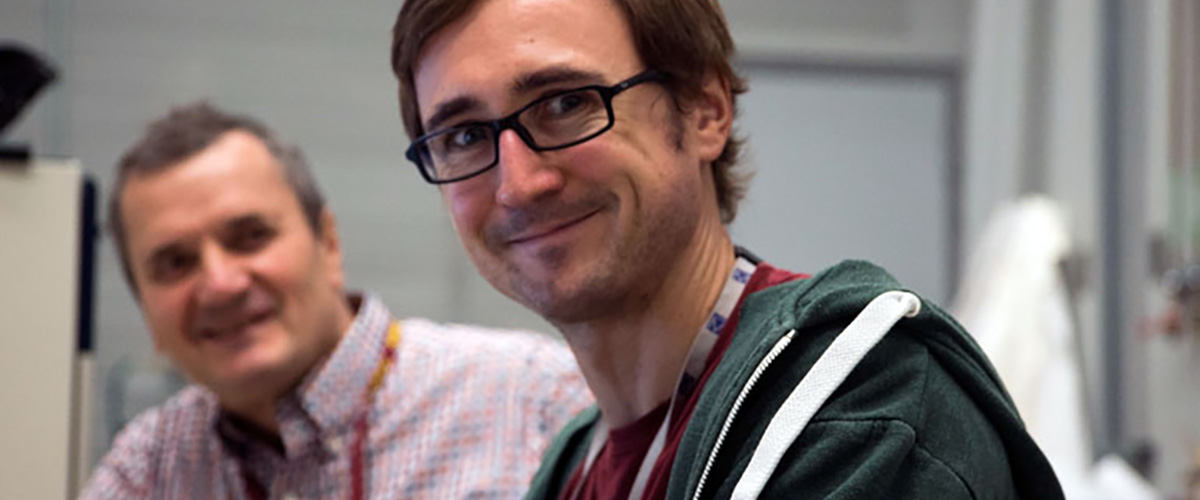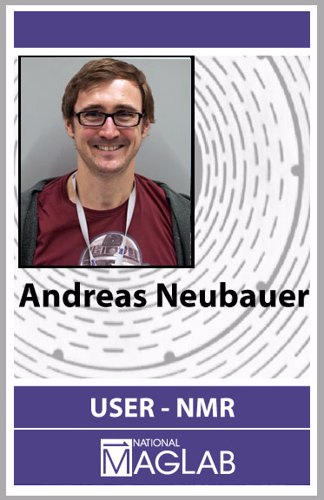
Andreas Neubauer took the extended stay option during his recent trip to the MagLab. After all, you can't rush art — especially when it's mixed with science.
Typically, scientists come to the MagLab for about a week to conduct an experiment in one of our magnets. After a few days, they take their data home, sort it all out and, with any luck, publish a paper.

Andreas Neubauer, a physics PhD student from Heidelberg University in Germany, is different. He just finished a half-year stint at the lab.
After all, it takes a while to write a symphony.
Don't take that literally: Neubauer, though an avid guitarist, isn't forsaking physics for music composition. He is, however, writing a long and complex piece of software called an MRI (as in magnetic resonance imaging) sequence that other scientists will be able to use to run certain kinds of MRI experiments.
Rather than notes, the sequence is made up of a series of precisely timed instructions that tell an MRI machine what radio frequencies (RF) to direct at its target — the thing or body part it is imaging — as well as how to adjust the small gradient magnets inside the MRI that help to create the image.
All MRI imaging requires a sequence. The software can be relatively simple, as for a routine scan at a hospital. Research scientists, however, often require complicated sequences that they must painstakingly code before their experiment. Neubauer is writing one such opus.
The task is huge: Neubauer first needed to learn the programming language — which seems sort of like picking up musical notation just before penning a cello concerto. Then came the coding, simulating, testing and tweaking. The work was exacting: While composers write in half and quarter notes, Neubauer's instructions must be timed to the microsecond.
"You have the idea and you know what it should look like, but there are these little tiny details you stumble over and you have to fix them," Neubauer said. "This is really time-consuming. From the idea to the actual sequence, it's always a long time spent."
Neubauer rented an apartment during his Tallahassee sojourn, commuting to the lab by bike. He spent a little time exploring the area — pub crawling, rock climbing, enjoying the local seafood — but mostly logged in a lot of hours on his project. Missing his girlfriend back home, the long days had their upside. "It kept me distracted," Neubauer said.
The idea to write this particular sequence originated with Victor Schepkin, a MagLab scientist who is pioneering a set of MRI techniques targeting sodium. With his interest in biophysics and software development, Neubauer thought it was the perfect project to cap his academic career. The opportunity to develop the sequence alongside Schepkin was key to the project's success. "Working with him really helped me focus in the right direction," Neubauer said.
Conventional MRIs create scans by directing specific radio frequencies at your body that are just the right wavelength to excite hydrogen atoms. Those atoms then send signals back to the machine revealing where they (and, by extension, all the water molecules in the body) are located. With that data you can create a map of the body's soft tissue and identify things like tumors or herniated discs.
Rather than hydrogen, the experiments Neubauer seeks to enable target sodium (or other electrolytes, like potassium and chlorine). As they travel in and out of cells, these atoms can provide information on important processes taking place in the body — a brain tumor succumbing to chemotherapy, for example, or a migraine boring a painful path through the cortex. Sodium MRI applies the more familiar MRI to the cellular level, providing a view of the body's building blocks in action.
The prospect of sodium MRI is exciting, said Neubauer; it could offer a non-invasive alternative to measurement techniques, such as injecting dye into the body, that disrupt the very processes they seek to observe. "It's physiological measurement without disturbing the environment," he said. "You really record what's going on without disturbing the system."
If this is so terrific, why aren't doctors using these kinds of scans now?
Sodium MRI is harder, in part, because there's less of it to work with. Hydrogen makes up 10 percent of the body: It isn't hard to find. But sodium, potassium and chlorine — referred to in the trade as X-nuclei — each make up less than 1 percent of the body. So they produce very weak MRI signals; sodium's signal is 20,000 times weaker than hydrogen's, and the signals of chlorine and potassium are weaker still.
You need a really strong magnet to detect those weak signals with any clarity. We have just the thing at the MagLab: The 900 MHz ultra wide-bore spectrometer, which features a world-record 21.1 tesla x Tesla, or T, is a unit of magnetic field strength; a strong refrigerator magnet is .01 tesla, and a typical MRI machine is 1.5 to 3 tesla. The MagLab's strongest persistent magnet has a field of 45 teslas. magnet. For Neubauer, who is limited to a 9 tesla magnet in Germany, it was like working with the Stradivarius of spectrometers. The world's strongest MRI machine, the 900 MHz is the "instrument" on which his software masterpiece will eventually be played.
Although X-nuclei are harder to see with MRI, there's a payoff: As complex atomic structures, they have the potential to convey more information than hydrogen. Hydrogen protons respond to RF pulses in MRI by absorbing their energy, then relaxing to send that energy back as a signal. They are one-trick ponies; in physics lingo, they have just one possible quantum transition.
But X-nuclei have a few more tricks up their sleeves — more possible quantum transitions, more possible paths for the RF energy to follow. This makes sodium MRI a more nuanced tool that lets scientists probe for different kinds of information. If they want to see a specific event — sodium ions crossing cell membranes, for example — they apply RF pulses and look for the specific quantum transition (a triple quantum transition, as it happens) that is evidence of that event.
To Neubauer, it's a graceful duet of physics and biology.
"What I like best about MRI is that it's applied quantum mechanics — you use quantum mechanics to generate an image," said Neubauer. "I like to help to understand the physics of living things."
This interdisciplinary approach has its challenges, though, because physics and biology are so different.
"When you do an experiment in physics, you always try to isolate your system. You want to observe one single process as clean as possible," said Neubauer. "And the challenge in biology is, you can't. In fact, biological systems are highly complex systems — it is almost chaos, a lot of processes are happening simultaneously, and you cannot isolate them."
That's where Neubauer's sequence comes in: Using physics, it applies some order on the chaos that is a living organism. "We have to find ways to look at physical processes in biological systems and to tear them apart, to isolate them," he said.
It's two disciplines coming together to make beautiful … science.
"I really like to work together with people from different fields," said Neubauer. "First, you learn a lot for yourself. And what you can do if you cooperate is just amazing."
Schepkin said his work with Neubauer has been rewarding and productive. "Andreas is an outstanding Ph.D. student," said Schepkin. "During our work together at the 21.1 T, we moved ahead with his research project dramatically."
When completed — probably sometime next year, Neubauer estimated — the final product will be available for download, free for any scientist to use.
By Kristen Coyne
More than 1,400 scientists come from across the world to use our unique magnets. If you have an experiment you would like to do here, find out how to request magnet time. Magnet time is free.
Last modified on 31 December 2022